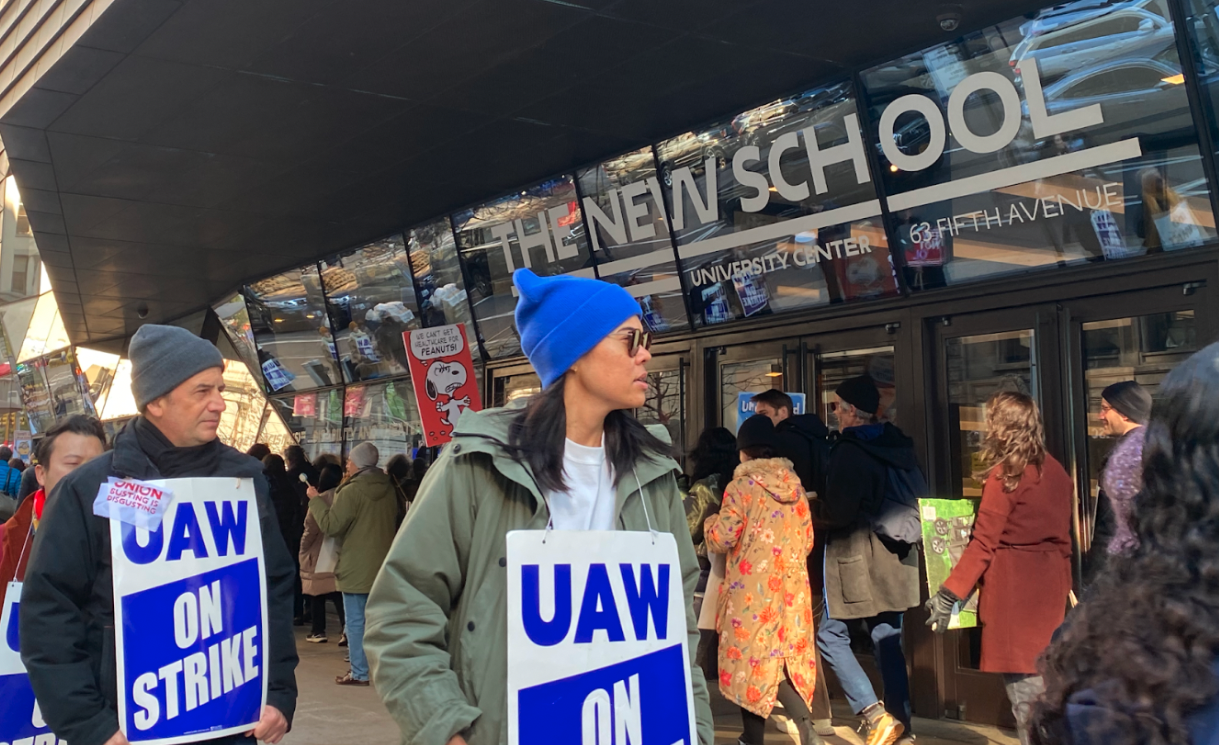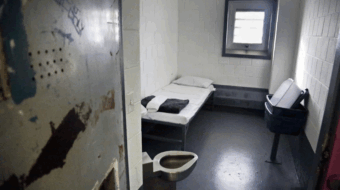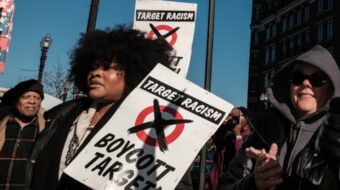
NEW YORK—“It’s not very on-brand,” striker R. Sikoryac said of The New School administration’s handling of strike by part-time workers belonging to ACT-UAW Local 7902. He added, “Although the faculty have been supportive and lived up to the school’s mission.” Another striker chimed in, adding that she gives the administration an F- on their handling of the strike.
On Wednesday, Nov. 16, The New School in New York City effectively shut down entirely after 97% of Local 7902 members voted to authorize the strike. The union has picketed the school’s flagship building University Center on Manhattan’s busy 14th St. every day the school has been open since. Strikers have been joined by some full-time faculty, students, and parents.
After the administration suspended piecemeal negotiations and published their offer to part-time faculty, the union pushed their members to vote ‘no.’ On Thursday, Dec. 1, the union reported that 95% of its membership voted ‘no’ on the university’s offer, with 1,821 votes against and only 88 votes for.
This result pushes the strike into a new, critical phase as the semester begins to wrap up over the next couple weeks, which raises questions about what will happen with final exams, papers, and presentations, and whether or not grades will be withheld in solidarity with a continuing strike.
The New School has always been recognized as a leading institution on the cutting-edge of scholarship on social issues. This history is so central to the New School’s identity that several of the classes offered this semester are proudly displayed on the facade of the university’s flagship modern building. Some examples include: “Inequalities and Varieties of Capitalism,” “Critical Fashion and Social Justice,” and “Artists as Activists,” an irony that was not lost on the picketers.
As a graduate student at the New School for Social Research, one of the six divisions of the university, this author respects both the contributions of the New School’s many part-time faculty members as well as the university’s illustrative history.
According to a statement by the AFL-CIO New York City Central Labor Council, part-time workers represent 87% of the faculty of the New School, but their salaries make up less than 8.5% of the university’s budget. After not receiving a raise since 2018, the part-time faculty workers’ real wages have been reduced by 18% as the city suffers a massive cost of living increase and the nation undergoes widespread inflation.
Only two days before part-time faculty at the New School went on strike, 48,000 academic workers (also with UAW) at 10 schools in the University of California system also walked off the job. This has been called the largest academic workers strike in U.S. history. With one group of strikers on the East coast and the other on the West, each has voiced solidarity with the other.
The union has received the support of several academic departments within the New School. Many full-time faculty members have endorsed the strike in solidarity, refusing to host classes. The administration suggested that faculty should hold online classes, but most faculty have simply refused.
In an interesting development for labor politics, the union has claimed that supporters should avoid crossing both the physical and digital picket line. The digital picket line has meant not hosting classes online, grading students’ papers, or even working on plans for next semester’s classes.
On the physical picket line, strikers have embodied the artistic side of the New School. Strikers from Parsons School of Design, a division of the university known for its art and design programs, have used their artistic skills to create puppets and signs using illustrations of characters like SpongeBob and Snoopy to criticize the administration. These signs have been heavily included in the union’s social media campaign, another indication of the increasingly-primary role technology plays in modern labor organizing.
In less than a week, the strike has garnered the attention of several local and statewide politicians. State Sen. Jessica Ramos visited the striking workers in person on Nov. 22. City Councilmember Crystal Hudson voiced her support on Twitter. The wave of attention from political leaders comes after union leaders perceived the offer from the New School administration as union-busting.
In a statement released to the New School community, including parents and students, the administration outlined a deal that included a 7% raise over the next academic year, with a 2.5% wage increase in the second through fifth years, a $2,100 bonus, and an updated healthcare plan that they claim expands eligibility and provides more options.
The administration says it didn’t intend to end negotiations, writing the offer “does not represent the university walking away from negotiations” in bold. Still, the union responded on its Instagram page, UAW Local 7902, claiming that the statement represented the administration leaving the bargaining table. The union went so far as to say the offer was union-busting, and it drew comparisons to recent anti-union behavior from Starbucks and Amazon.
In the run up to the membership vote, the union posted infographics detailing the differences between the administration’s offer and the union’s ask. For example, one post outlines the union’s proposal on job security, highlighting the need to protect faculty from the university lowering faculty base loads and setting a two-course minimum per year for faculty that are annualized. Another post compares the union’s demands on compensation and a pandemic bonus with the university’s offer, with the union asking for a minimum of $6,379 per 45-contact-hour studio course instead of the $4,600 offered by the university.
In defending its offer, the administration emphasized how tight the university’s budget is. According to the university, the union’s proposal on compensation would cost $683 million over a five-year contract and the entire operating budget for 2023 is only $454 million. The union claims the budget is mismanaged and more money should be diverted from administration to faculty, highlighting that 52.8 cents are spent on administration costs for every one dollar spent on instruction.
Claire Potter, New School professor and editor of the school’s periodical Public Seminar, wrote that the challenges facing The New School are the same problems being faced by universities across the country. She writes that academia, and specifically the deepening divide between tenured professors and part-time faculty, needs to be restructured to succeed in the 21st century.
These problems are not unique to the New School, noted Judith Friedlander, former Dean of the Graduate Faculty of Political and Social Science (now the New School for Social Research) and author of A Light in Dark Times: The New School for Social Research and Its University in Exile.
“The strike at the New School,” she explained to People’s World, “is part of a national movement, which has the support of both full-time and part-time faculty, as well as graduate students, all of whom are protesting a policy, found on many campuses across the country, of eliminating tenure-track positions and replacing them with badly paid part-time instructors, many of whom are qualified PhDs who, given the current climate, can’t find a full-time job.”
The New School, which traditionally focused on providing adult education courses, has always maintained a large roster of part-time instructors, most of whom, however, especially in the early days, had been otherwise employed. They did not expect to earn living wages by teaching at The New School.
Things today are very different, Friedlander continued, making this strike “particularly problematic for an institution that has continued to depend heavily on part-time faculty, many of whom remain as gifted as their predecessors, but who are now trying to survive financially as adjuncts.”
The union has been making this critique clear. As the strike continues, the union has scheduled a series of talks to unpack the school’s legacy as well as detail how this strike can serve as a catalyst for reform in academia.
So far, “Strike School,” put on by “The New School Faculty in Exile” (a play on the famous University in Exile, an institution the New School built to provide refuge for scholars fleeing Europe during World War II), will include seminars like “A Short History of Labor in the U.S.,” “The New School as a Neoliberal University,” and “On the Poverty of Student Life.”
Depending on the outcome of this strike, as well as the other UAW strike of the UC system, academia could be seeing the beginnings of a major reform movement, where the university system is restructured to reduce precarity and provide stability to the many part-time faculty it relies on.










